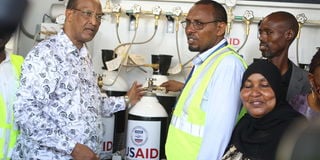Garissa County adopts first oxygen plant, saving more than Sh500,000 a month

Garissa Governor Nathif Jama (left) at the newly launched oxygen plant at the county referral hospital on May 22, 2023.
Garissa County will save up to Sh600,000 per month and serve more patients at the county referral hospital with the introduction of its first oxygen system.
The 283-litre-per-minute Pressure Swing Adsorption (PSA) oxygen system, worth Sh27 million, can produce medical oxygen from the air clean enough to be used by patients in the hospital and shared with nearby health facilities. The plant can fill 10 cylinders in 24 hours.
The project’s funder — United States Agency for International Development (USAid) — signed a two-year contract with the Garissa County Government to provide raw materials for oxygen production and maintenance of the facility.
Governor Nathif Jama said partnering with the agency and other organisations like Jhpiego is a strategy for counties to attract support to augment the county's investment in building fragile health systems, especially in the northeastern frontier.
"We are hiring more health workers, building hospitals, but we need support to equip them to serve the community," Mr Jama said.
He added: "We have been without this facility for a long time and during the Covid-19 pandemic, many of our people died because of lack of oxygen in Garissa.”
The Garissa county chief has pledged to ensure the oxygen plant is well maintained and that more specialists are recruited to provide the service.
At least 12 medical staff, including nurses and anaesthetists, were trained in basic emergency care during an intensive five-day course as part of the project.
"With such an essential service, we will soon become a Level Five hospital. From this facility, we will be able to serve all the sub-county hospitals in Garissa," he said.
Refugees hosted in the county will also benefit from the oxygen plant.
With a population of one million, Garissa County has the highest number of refugees in Kenya, hosting two out of every five refugees in Kenya.
In 2021, Garissa hosted 236,254 of the total 540,068 refugees (about half of the county's population), mainly from Somalia, South Sudan and the Democratic Republic of Congo, who sought care at Garissa County Referral Hospital.

Garissa governor Nathif Jama (center) and county executive member for health Ahmednadhir Omar join women in a dance on May 22, 2023. Garissa launched its first oxygen plant funded by USAID.
The 2023 Economic Survey shows that the county received Sh8.8 billion in the last financial year, when it battled a devastating drought.
Garissa County Health Executive Ahmednadhir Omar said the county was spending at least Sh245,000 a month to buy oxygen from as far away as Nairobi, an amount that does not include transport costs, for patients at Garissa County Referral Hospital alone.
"Our hospital has a catchment area of four million people and treats patients referred from 126 health facilities in the county and from neighbouring Tana River, Kitui, Isiolo and Wajir counties. The hospital also receives patients from Somalia," said Mr Omar.
The PSA oxygen generator is the most cost-effective means of delivering oxygen compared to storing it in cylinders that need to be refilled, which is 10 times more expensive and what the county has been using, the health executive said.
Oxygen saves lives, and the World Health Organisation has classified it as an essential drug for use in emergency respiratory resuscitation around the world for severe pneumonia and other lung diseases.
Oxygen is also used to treat conditions that can lead to hypoxaemia (low levels of oxygen in the blood), including sepsis, severe malaria, trauma and cardiovascular disease.
It is also essential for surgical care, intensive care units (ICU), high dependency units (HDU) and anaesthesia.
Oxygen, like other medicines, requires skills to administer it appropriately according to the medical needs, age and weight of the patient.
The oxygen system was installed under the Reaching Impact Saturation and Epidemic Control (Rise) project funded by USAid.





